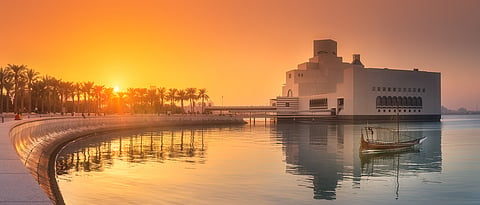

Asked to design the Museum of Islamic Art in Doha, the capital of Qatar, architect IM Pei requested for a special space that will prevent other buildings from crowding out the museum in the future. While many may consider it as a whimsy of the Chinese architect, as a Kolkatan, I realised the importance of such a request. The Indian Museum in Kolkata, established in 1814, is not only jostled by other buildings but an ugly flyover nearly hides its faade. Pei was given a man-made island off the Corniche where he built the iconic museum, which was opened to the public in December 2008.
With the sweeping promenade of The Corniche, Dohas famous waterfront, behind us, we drove past a tree-lined pathway to reach the bridge that connected to the artificial island on which stood Qatars Museum of Islamic Art. It is said that much-acclaimed architect IM Pei was drawn out of his retirement to design this museum. But Pei said that the museum must be in an area where it would not be crowded out by other buildings. And thus it stands today, surrounded by a huge park and the sea.
To an uninitiated person like me, the building at first appeared to rise like a stack of boxes placed on top of each other, some at impossible angles. A form of cubism I cannot say. The top-most part contained a pair of eye-like slits. Later, we learned that the 13th-century ablution fountain (sabil) of Egypts Mosque of Ahmad Ibn Tulun in Cairo was the inspiration for the building. The cream limestone made the exterior look soothing in the scorching daylight but the clear geometric lines gave it an air of austerity.

Then came the big surprise. Little did we realise that the angular austerity contained within itself a magnificent domed atrium, with natural light pouring in from a glass wall that rose along the entire five floors of the building. Stylistic use of glass, metal and stone, minimal use of colour, bold patterns on the floor, chandeliers, added to the grandeur of the elaborately planned central hall, a sharp contrast to the sombre exterior. A curved flight of stairs rose along the centre of the hall.
With less than an hour at our disposal, we decided to take the elevator to the top, choose to see the displays of our interest from the signage provided on each floor, and descend by the staircase. Said to hold one of the greatest collections of Islamic Art, the museum largely contains metalwork, ceramics, jewellery, woodwork, textiles, coins and glass. The permanent exhibits are displayed across Floor 2 and 3. Floor 2 contains an eclectic collection depicting figure in art, pattern, calligraphy, and science. Floor 3 contains exhibits of early Islamic art dating between 7th and 12th century as well as exhibits from Central Asia and Iran, Egypt and Syria, India, and Turkey most of these collections dated between 12th- and 19th century.

The displays are housed in glass cases and well-lit, with enough space to move around easily. According to the MIA, it probably holds the oldest surviving Islamic astrolabe (a two-dimensional map of the heavens which shows the movement of celestial bodies) in the world. Made in Iran, it dates back to the 9 th century and was found off the coast of Malaysia. The collection of scientific instruments and maps is interesting.
The ceramics and textiles are excellent studies of the evolution of artistic style, colour and pattern over centuries across the Islamic world. We saw some fine jewellery and other collectables from Mughal India.
The manuscripts, over 800 of themfrom 7th century Qurans to 19th century Ottoman works, books on science, literature and religious subjects can take up a large chunk of your viewing time. It is here that you will get to see the famous Abbasid Blue Quran, one the finest and rarest manuscripts in the Islamic world. The museum displays two of only five known pages from the largest Quran in the world, the Timurid Baysunghur Quran. The Khamsa of Amir Khosrow Dehlavi in ink, opaque watercolour and gold on paper from 15th century Iran held us spellbound. Needless to say, we were hopelessly behind schedule and hurried down as our desperate guides began to call and remind us of our next stop. Casting a sorrowful eye at the pretty caf that was located next to the glass wall on Floor 1 and offered a nice view of the bay, we stole a few minutes on our way out to catch a hurried look around the Museum Store. If you have to buy something here, do check out the Desert Rose (colloquial name for rose-like crystal clusters of gypsum, found in arid areas).
Getting there The Museum of Islamic Art (MIA), located off the Corniche, is around 15 minutes drive from Dohas Hamad International Airport, and within walking distance of Souq Waqif. In winter, when the weather turns pleasant, the MIA Park holds a lot of activities.
Museum Info MIA is open on all days of the week (except for some local holidays, such as Eid).From Saturday to Thursday, it is open from 9am to 7pm on Friday, from 1.30pm to 7pm. Last admission 30 minutes before closing. Galleries, gift shop and caf shut 15 minutes before actual closing time. Every Thursday and Saturday, there is a free 40-minute guided tour, starting at 2pm, in English and Arabic. The museum is fully accessible multi-media guides for the visually impaired are available on request. The reception and information centre are to your left as you enter. No entry or photography charges. However, flash and tripod photography not allowed. Cloakroom, washroom, gift shop, caf, free wi-fi and ATM available. The MIA is a no-smoking zone.
